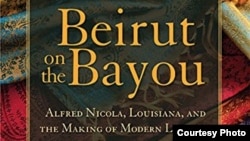A mainstay in Lebanon for more than five decades, the respected Al-Kafaat Foundation stems from the success of Habib Shwayri, who emigrated to the United States, settled in Louisiana and defied the odds to build a clothing empire and make a fortune.
That journey and the transformative ripple effect it had are the subject of a new book, Beirut on the Bayou, by his grandson, Raif Shwayri. How it all played out makes for a fascinating story.
In 1902, Habib Shwayri arrived in Ellis Island — where his name was changed to Alfred Nicola — with the goal of making his way to relatives in New Orleans. He became a door-to-door salesman, selling his wares down the Bayou Lafourche, a 170-kilometer-long bayou in southeastern Louisiana. For 18 years in rather harsh, primitive conditions, Nicola made a good living peddling basic staples, and he sent most of the money back to his family in Lebanon.
In this book written by his grandson, Raif Shwayri (Rah-eef Sh-way-ree), the American dream for Nicola became a reality. He became a very wealthy man as a result of inspired hard work and a plan for success, and ultimately that success turned into the iconic and unique institution, Al-Kafaat.
The Al-Kafaat Foundation has served more than 40,000 disabled and disadvantaged Lebanese people of all ages and beliefs. It provides essential social, medical and educational rehabilitation.
The foundation also houses Al-Kafaat University, an inclusive, community-driven college, which now is affiliated with the State University of New York. SUNY implemented the Lebanon Project, which integrates funded programs and independent, collaborative educational programs among several SUNY campuses and Al-Kafaat University.
WATCH: For Alfred Nicola, American Dream Becomes Reality
'Resilience'
Raif Shwayri, describing what it took to be an immigrant entering the country with $20 in his pocket, said the key word was “resilience.” He said most immigrants at the beginning of the 20th century could not fathom the magnitude of the travels upon which they were embarking. He said his grandfather, like many other immigrants, was tough, resourceful and persevering.
Why did he come to America? According to anthropologist Linda Jacobs, the thriving silk industry in Lebanon collapsed at the end of the 19th century with the opening of the Suez Canal, allowing cheaper silk goods from Asia to compete with and choke off the Lebanese silk industry.
“Forty percent of the economy in Lebanon and Syria came from the silk culture. People needed to find a new way to survive,” said Jacobs. And it was the beginning of the end of the Ottoman Empire, which controlled the Syrian-Lebanon area.
So Nicola, a single man at the time, wound up in Louisiana, where he had cousins who had come to America earlier. He became a salesman of goods, door to door and on the street.
“This Bayou Lafourche, outside of New Orleans, was a land where no one knew anyone’s name,” Shwayri told VOA. “Everyone had a nickname. My grandfather was known as 'Sweet Papa.' He would trust his customers, leave them clothing or knickknacks that he carried on his back in a fold-up valise, and get paid later.
The backpack valise became a trademark of all Syrians and Lebanese working in America. And perhaps more importantly, he started a new trend of ready-to-wear clothing, rather than custom-fitted garments.”
Peddling goods
Jacobs, whose grandparents all came from the Lebanese-Syrian area, described the business of peddling:
“Peddling is incredibly lucrative, believe it or not. Every Syrian and Lebanese oral history talks about this. Syrians and Lebanese who worked in silk factories or cotton mills in the 19th century made $4 per week. Peddlers netted $50 a week. It was incredible, and it was what enabled every Syrian-Lebanese peddler to start his own business.” Syria and Lebanon were viewed as one country at the time.
After 18 years of peddling, Nicola returned to Lebanon. During that time in Louisiana, he had sent much of his earnings back to his family. When he returned to his homeland, Nicola worked for banks and wisely invested his savings from peddling in Lebanese real estate.
After Nicola died, Raif’s father, Nadim Shwayri, turned his part of the inheritance into the endowment that started Al-Kafaat. All of Nadim’s children, according to Raif Shwayri, had to forgo much of their inheritance in order to fund the endowment.
According to Lina Beydoun, an official of the Lebanese American University in New York, Lebanon today represents pluralism. Beydoun proudly states that “Lebanon is representative of religious tolerance and freedom. The Lebanese community is represented by 17 sectarian groups, all officially recognized. We cannot survive without each other. We are all minorities.”
Raif Shwayri now lives in Beirut, and proudly talks about a determined Lebanese people.
“Lebanon, despite sitting at a crossroad of problems in a troubled Middle East, and ... 17 years of civil war, still has a strong and active civil society," he said. The question he asks is, “What will Lebanon be tomorrow?”








